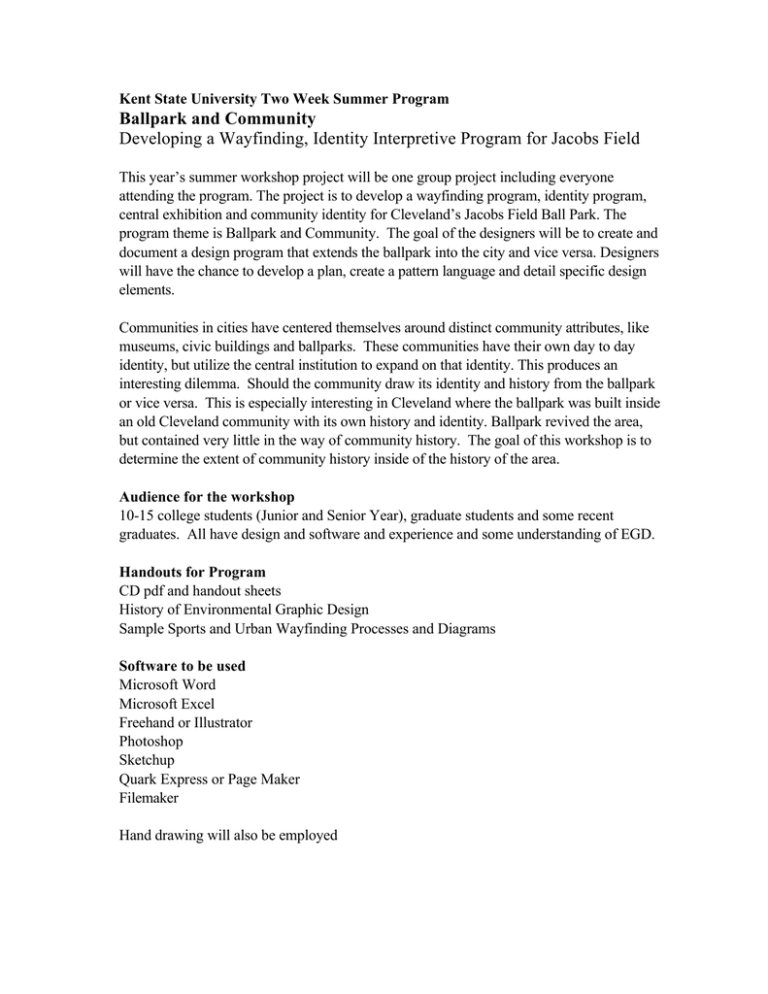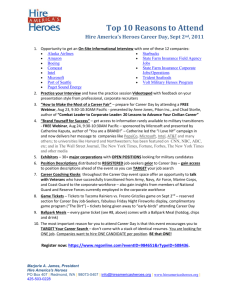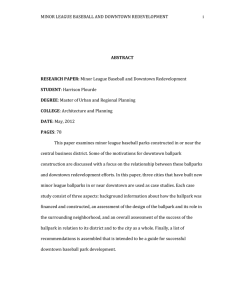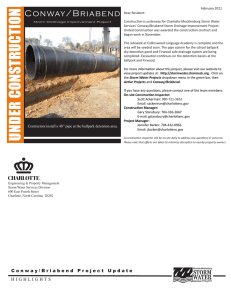Ballpark and Community
advertisement

Kent State University Two Week Summer Program Ballpark and Community Developing a Wayfinding, Identity Interpretive Program for Jacobs Field This year’s summer workshop project will be one group project including everyone attending the program. The project is to develop a wayfinding program, identity program, central exhibition and community identity for Cleveland’s Jacobs Field Ball Park. The program theme is Ballpark and Community. The goal of the designers will be to create and document a design program that extends the ballpark into the city and vice versa. Designers will have the chance to develop a plan, create a pattern language and detail specific design elements. Communities in cities have centered themselves around distinct community attributes, like museums, civic buildings and ballparks. These communities have their own day to day identity, but utilize the central institution to expand on that identity. This produces an interesting dilemma. Should the community draw its identity and history from the ballpark or vice versa. This is especially interesting in Cleveland where the ballpark was built inside an old Cleveland community with its own history and identity. Ballpark revived the area, but contained very little in the way of community history. The goal of this workshop is to determine the extent of community history inside of the history of the area. Audience for the workshop 10-15 college students (Junior and Senior Year), graduate students and some recent graduates. All have design and software and experience and some understanding of EGD. Handouts for Program CD pdf and handout sheets History of Environmental Graphic Design Sample Sports and Urban Wayfinding Processes and Diagrams Software to be used Microsoft Word Microsoft Excel Freehand or Illustrator Photoshop Sketchup Quark Express or Page Maker Filemaker Hand drawing will also be employed First Week The Ballpark and the Community Day One – June 18 – 9:00 am start Kent State Urban Center in Cleveland Lecture 1: The Ballpark and the Community Schedule: Sponsored by ASI-Modulex 9:00 Morning: Opening Lecture by Craig Berger 12:30 Photo tour of the Cleveland Ballpark 3:00 Char Catt Lyon speech to large group 4:40 Brainstorming Session on ballpark ideas 7:05 Game Tour of the Ballpark Area Project 1: How to conduct a site audit and create a mission statement of the ballpark and community area. Photo tour of the ballpark area Brainstorming Session. Speaker – Char Catt Lyon at 3:00 PM and Craig Berger Exercise 1: Project overview. Split into two groups. One group conducts a photo survey of the ballpark. The second group conducts a photo survey of the community. These photo surveys should break down the gateways, main paths, key nodes, landmarks, districts and areas of interpretation. The brainstorm session will be conducted as a single group. Tasks Split into two groups Begin site audit Create a Mission Statement as one group Create an initial conceptual plan Software Used – Excel, Pagemaker or Illustrator. Day Two - June 19 – 10:00 AM Lecture 2: EGD and the Ballpark. Planning and Implementation. Integration of Brand into environmental graphic design Systems integration. Tying all the elements together Developing a kit of parts Speaker – Rachel Downey Speaker – Sue Youngblood Exercise 2: Complete site audit. Begin wayfinding planning exercise. Select sign vocabulary and apply to a preliminary excel. message schedule of recommendations. Create site map with basic routes and design recommendations. Create sign plan two routes, and primary route and a secondary route, as well as sign recommendations for each route. Tasks Complete Site Audit Complete Mission Statement Develop an Initial Storyline and Narrative of the town and ballpark Complete the Concept Plan, with major destinations Selection of Components Community One Identity Component - Billboard, gate, sign, supergraphic, mural, electronic element One wayfinding component – Map, sign, dynamic element One interpretive component – Exhibition, sculpture, sign, pavement Ballpark One Identity Component - Billboard, gate, sign, supergraphic, mural, electronic element One wayfinding component – Map, sign, dynamic element One interpretive component – Exhibition, sculpture, sign, pavement Day 3 – June 20 – 10:00 AM Lecture 3: Craig Berger – Stadiums, Ballparks and Communities. Reading a Building, and Reading Community Architecture. Discussion: Craig Berger and David Middleton — Identity for Heritage and Community Projects. Architecture, Icons and Imagery Exercise 3: Parti drawings and photo montages. Begin of Design Development Process Tasks Finalize Wayfinding Route, Concept and Plan Begin design development of preliminary sign elements Begin the design of the identity Create a special visual language to use across the entire project Select Preliminary Typography, Colors, Materials Day 4 – June 21 – 10:00 AM Lecture 4: Developing a kit of parts for a wayfinding program Speaker – Miranda Hall Carrier Exercise 4: Develop a basic sign vocabulary of elements in free-hand and a written description of each element describing how the identity and wayfinding plan was incorporated into the design analysis. Create a description sheet for each element describing how they are to be used in the project. Describe how colors and symbols will be used. Tasks Finalize preliminary design elements Finalize site audit, strategic plan and hierarchy. Create a plan to integrate gateways, icons, lighting and art into identity. Day 5 - Final Critique – June 22 – 2:00 PM Final First Week Critique Miranda Hall Carrier Sue Youngblood Craig Berger Preparation for Second Week. Complete and package all elements. Create one sheet of multiple sign elements in elevation scaled to each and a person, and photo montage of sign elements in key locations. Second half of the day. Second Week June 25-June 30 Fabrication and Documentation Day One - June 25 – 9:30 AM Lecture 1: The Elements of the Design Intent Document Package Speaker – George Limm Exercise 1: Convert the sign elements from week one to a design intent document elevation in freehand or illustrator in scale with color without materials. Tasks Final schematic development using hand drawing. Final development of design palette. Begin design development of design vocabulary using illustrator Day Two – June 26 – 10:00 AM Lecture 2: Documenting two dimensionally Speaker – George Limm Exercise 3: Draw one sign element on freehand in a top, and side view, by hand or software, and measured photo montage to show installation. Begin developing dimensioned drawings Day Three – June 27 – 10:00 AM Lecture 3: Selecting and specifying Materials and Methods for the fabricator Lecture 4: Taking Design the Design Process Three Dimensionally Speaker – Kevin Fromet – ASI Modulex John Mishke – Studio 505 Exercise 3: Select materials and write the specifications for their use on the design intent drawing package. Get materials folders at conference from all of out vendors. Select final colors and materials for use in the design package Finalize design development Development of complete sign package Day Four –June 28 – 10:00 AM No lecture. Begin final. Exercise 4: Final development of the egd package and creation of a portfolio in egd. Put all the documents together from week one and week two. Day 5 - Final Critique – June 30 – 1:00 PM Complete one sign element as a sign design package. Second half of the day. Outcomes Students at the end of the two weeks this is the final required documentation. Week 1 List of potential brainstorming ideas Written Project Concept and Goals. The concept will also contain information on how it relates to the other group concept Map of the area explaining project concept, key destinations and key locations for project development List and description of kit of parts being employed, including one wayfinding element, one identity element and one interpretive element Analysis of type of design elements being considered Palette containing color, typography, pattern, identity. The palette will also contain a description on how it links to the other team’s kit. Schematic drawings of individual elements of design vocabulary in freehand drawing and photo montage. Final Week one: 11”x17” program presentation in pdf format containing all the above elements. Week 2 Continued design development in freehand drawing Design development in measured drawings in plan and elevation. Three dimensional drawing of the design object Photo montage of the design object One written specification for material selection and one for lighting selection on the measured drawing. Final Week Two: 11”x17” program presentation in pdf format containing all the elements from week 1 and 2. Potential Design Elements Plan - How should the place be interpreted and its story be told? What locations should be profiled and developed as part of this history? Identity - How should a neighborhood identity be defined? Should it be closely aligned with an overall heritage area, or should it have a distinct identity? The identity will be graphic, and find its expression in architecture and landscape. Gateways and pedestrian elements. Logo design. Interpretive Design – There are a number of ways a community can be interpreted including signs, sculpture and landscape. The workshop will explore both traditional and nontraditional interpretive elements. The central product is a core interpretive sign element. Wayfinding – How are the interpretive elements connected, and how do they relate to the overall identity of the place? Map - A special map will be developed of the neighborhood that will specifically define the nature of the place and the connected interpretive elements. Dynamic Elements – Can movement be integrated into the environmental graphic design scheme and how will that be employed.



